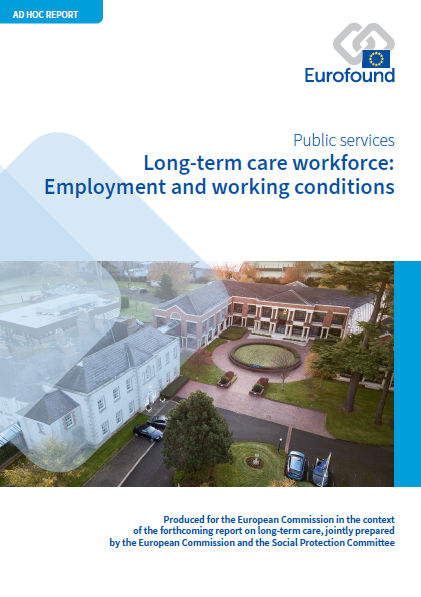
The long-term care (LTC) sector employs a growing share of workers in the EU and is experiencing increasing staff shortages. The LTC workforce is mainly female and a relatively large and increasing proportion is aged 50 years or older. Migrants are often concentrated in certain LTC jobs. This report maps the LTC workforce’s working conditions and the nature of employment and role of collective bargaining in the sector. It also discusses policies to make the sector more attractive, combat undeclared work and improve the situation of a particularly vulnerable group of LTC workers: live-in carers. The report ends with a discussion and policy pointers on addressing expected staff shortages and the challenges around working conditions.
Key findings
Around 6.3 million people work in the long-term care sector in the EU – up by one third in just one decade – while 44 million people provide frequent informal long-term care to relatives or friends.
The proportion of workers aged 50 years or older is higher than in other sectors, and is increasing at a faster pace: from 28% in 2009 to 38% in 2019.
Working conditions in the sector are characterised by physical challenges such as lifting people and working with potentially infectious materials – the risks being high in the sector as the workforce is older.
Exposure to adverse social behaviour at work means there is a high risk of developing mental health problems, thereby accentuating gender differences as the workforce is predominantly female.
Better staffing levels and more training, with public funding leveraged to set standards for care work, can all contribute to improving working conditions, addressing staff shortages, and ensuring access to high quality long-term care.
List of tables
- Table 1: Long-term care staff composition in Czechia: full-time equivalent public LTC workers, by profession and service, 2018
- Table 2: Staff turnover rates, LTC, the Netherlands (%)
- Table 3: Projections of LTC staff shortages or increases in staff/care demand/needs
- Table 4: Estimates of the LTC workforce by setting, 2018
- Table 5: Hourly earnings in social services (residential LTC and non-residential care) and healthcare as a proportion of national earnings, 2010, 2014, EU Member States and Norway and the UK (%)
- Table 6: Low-end pay in LTC, EU Member States and the UK
- Table 7: Illustration of variations in wages by LTC profession, Luxembourg
- Table 8: Minimum pay for domestic workers and private non-profit residential LTC workers, Malta, 2019
- Table 9: Staff–user ratios in LTC, 2017
- Table 10: Prevalence of adverse social behaviour by sector, EU27 and the UK, 2015 (%)
- Table 11: Collective agreements in LTC and coverage of collective bargaining, EU27 and the UK, 2019/2020
List of figures
- Figure 1: Long-term care workers as a share of the total workforce, by Member State, 2019 (%)
- Figure 2: Long-term care workforce by gender, compared with healthcare and the entire workforce, EU27 and the UK, 2019 (%)
- Figure 3: Long-term care workforce by age group, compared with healthcare and the entire workforce, EU27 and the UK, 2019 (%)
- Figure 4: Types of contract: LTC, healthcare and the entire workforce, EU27, 2019 (%)
- Figure 5: Self-employment in LTC, compared with healthcare and the entire workforce, EU27, 2019 (%)
- Figure 6: Job quality indices by sector, EU27 and the UK, 2015
- Figure 7: Full-time and part-time workers: LTC, healthcare and the entire workforce, EU27, 2019 (%)
- Figure 8: Preferences for working hours, EU27 and the UK, 2015 (%)
- Figure 9: Reasons for working part time: LTC, healthcare and the entire workforce, EU27, 2019 (%)
- Figure 10: Evening, night, Saturday and Sunday work, EU27, 2019 (%)
- Figure 11: Shift work, EU27, 2019 (%)
- Figure 12: Shift work by type of work, EU27 and the UK, 2015 (%)
- Figure 13: Work–life balance by sector: shift and part-time work, EU27 and the UK, 2015 (%)
- Figure 14: Feeling informed about health and safety, EU27 and the UK, 2015 (%)
- Figure 15: Impact of the job on health, EU27 and the UK, 2015 (%)
- Figure 16: Usefulness of the work, EU27 and the UK, 2015 (%)
- Number of pages
-
84
- Reference nº
-
EF20028
- ISBN
-
978-92-897-2127-1
- Catalogue nº
-
TJ-03-20-684-EN-N
- DOI
-
10.2806/36712
- Permalink
- Produced at the request of
-
the European Commission in the context of the forthcoming report on long-term care, jointly prepared by the European Commission and the Social Protection Committee
Cite this publication
Eurofound (2020), Long-term care workforce: Employment and working conditions, Publications Office of the European Union, Luxembourg